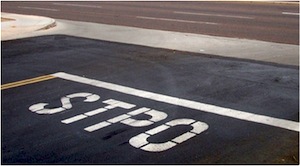How much embarrassment can one typo cause? More than you’d think.
 Of course, this road sign misspelling of “RIGHT TURN ONLY” (just kidding – “STOP”) is an extreme example. The typos you make at work probably won’t ever find their way onto The Tonight Show with Jay Leno (where I originally saw this STPO picture), but they can still cause you embarrassment and even damage your professional reputation.
Of course, this road sign misspelling of “RIGHT TURN ONLY” (just kidding – “STOP”) is an extreme example. The typos you make at work probably won’t ever find their way onto The Tonight Show with Jay Leno (where I originally saw this STPO picture), but they can still cause you embarrassment and even damage your professional reputation.
When a colleague sends out documents with frequent typos, many of us cannot help but view that colleague as careless and even less competent than she truly is. But that doesn’t need to happen to any of us. Effectively proofreading your work and catching typos is easier than you might realize.
So, when you’re finished writing your document and you’re ready to send it out… stpo! First, use some or all of these proofreading techniques.
1. Use Search or Find to catch sneaky errors like these
If you write “form” when you mean “from,” or “not” instead of “now,” spell-check won’t catch the errors because the words aren’t misspelled. But here’s a trick to catch these sneaky typos.
Keep a list of your most common errors. Then, when you’re done writing your document, use your Search function to look for them.
If you’re pretty sure you didn’t use the word “form” anywhere in your document, but you did write “from” a number of times, type “form” into your document’s Search bar. If it shows up, just review the context around the word to determine whether it’s a typo or a legitimate use of the word.
2. Print the document out
I think one reason we often can’t see mistakes in our writing is that we review our work in the same format and in the same place we created it – on our computer screen. Your brain tends to read what you think you typed, rather than what you actually typed, and it’s a lot easier to make this mistake if you’re proofreading in exactly the same environment where you wrote the material.
Putting your document into a slightly different format than the one you used to write it – in this case, a printed sheet of paper – will force you to read it a little differently, because it will be just a little less familiar to you than the onscreen version you just spent so much time with.
3. Read it out loud
Reading your document out loud as you proofread it can benefit you in two ways. First, you read more slowly out loud than you do silently, because you have to sound out each word. This will force you to spend a bit more time reviewing each word, each phrase, each point you’ve made. As a result, you’ll be more likely to spot an error than if you simply blast through the text reading it silently to yourself.
Second: When you read out loud, you’re able to put your document to an entirely different test – how it sounds. You can hear how your reader might read – and interpret – your words. Did you write a tongue twister of a phrase that will likely trip up your reader? Did you repeat yourself in different sections of the document and hadn’t noticed before? Were you sure that you wrote a certain point clearly, but when you hear yourself say the words out loud you find it’s not so clear after all? Reading your own words out loud can unveil all sorts of hidden issues.
4. Give your document time before proofreading
All of the techniques mentioned to this point, although helpful, might still fail you if you’re proofing a document you finished writing just seconds or minutes earlier. That’s because what you intended the document to state is still so clear in your mind, it could overwhelm even all of these other tricks to force yourself to read what’s actually there.
Give it a full day, if possible, but at least several hours. The more you can forget how you meant a given sentence to read, the more likely you’ll be to catch any mistakes in that sentence.
Related tip: Don’t leave your writing until the last minute. Leave yourself enough time to write, set aside, then proofread and send the document before your deadline.
5. Ask a trusted colleague to proofread it
What all of these other techniques have in common is that they are designed to help you review your work with more objectivity, a fresher set of eyes, than you’ll naturally have as the document’s author.
But the single best strategy is to have your written work proofread by a truly fresh set of eyes – a trusted colleague, preferably someone who had nothing to do with the document’s creation and hasn’t seen any portion of it during your drafting phase.
We all have our own proofreading systems. What are yours? If you have a proofreading tip or routine that works for you, please let us know.

